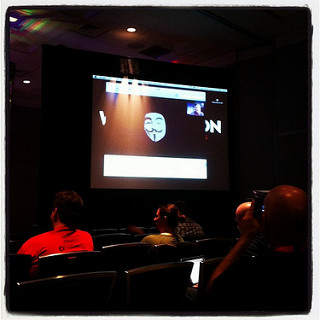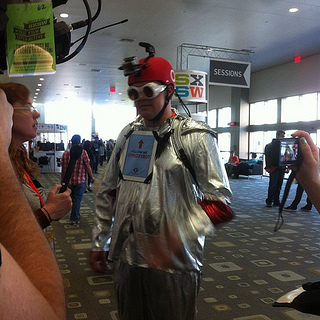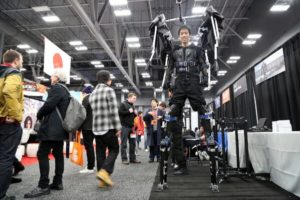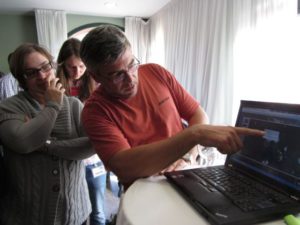If you want to get a taste of what new tools and trends we’ll be seeing in world of digital creativity, interactive technology, and networked activism over the next few years, SXSW in Austin, Texas, is a great place to put up the periscope. Originally founded as a music and film festival, a “multimedia” event splintered off in 1995 and became, in 1999, SXSW “Interactive” — described as a “breeding ground for new ideas and creative technologies” and the largest conference of its kind in the world.
This is my sixth SXSW. I was here in 2007 when Biz Stone decided to showcase his crazy startup called Twitter to a bunch of early adopters in a concentrated geographical location. (=Recipe for BOOM) He spent $11,000 to put up screens in the corridors and meeting rooms to feed live commentary back into the conference and let a bunch of digital creatives play in the lego pit he’d built. Twitter had under a million accounts at that time. I joined on March 10, 2007, as user 873,141.
Reportedly there are now more than 500 million accounts. Twitter changed SXSW profoundly: it was like having an MRI of the hive mind: the tweet-o-sphere was hosting a secondary conversation about panelist’s content, mediating IRL movements of people from room to room to find better panels, doing public service announcements about food truck quality and location, and providing a broadcast service for questions, comments, and raspberries.
Back then, the entire conference fit into a corner of the Austin Convention Centre. Today, the SXSW campus takes up a good chunk of the city of Austin and following any single tag like #SXSW is impossible — the hive mind has fractured into a thousand shards. And given every single startup in the world wants to do what Twitter did, the conference draws a dizzying array of digital creatives, designers, code jockeys, deep thinkers, futurists, synthetic biologists, entrepreneurs, marketers, shysters, sellers of vaporware, swag-peddling jesters in astronaut suits, giant cuddly animal mascots, robots, and students of the “every trick in the book” school of attention-grabbing.
Dodge ball, and then Foursquare, did a bit of the break-out act at SXSW as well, but there hasn’t really been a wildfire app launch of the Twitter ilk since. But, as Bruce Sterling stated in his closing address: “If you guys had a twitter every year at SXSW, you’d spontaneously combust.”
I go to SXSW to watch the horizon, to catch early warning signals, and monitor for things we can bend to activist purposes. Here’s a few of the signals I picked up this year:
Geolocating Social Apps
Hands down, these were the buzz going into the conference: apps that expose your secondary and tertiary connections to people near you, as determined either by app proximity alone or a checkin via FourSquare. I trialled Banjo, Highlight, Glancee, Localmind and Sonar. Highlight got the most attention, had the biggest presence at the conference, and drained my battery for no good purpose. The app alerts you if anyone ‘interesting’ is near, and defines interest by common twitter/facebook followers/likes.
My issue: it seemed to be great at telling me who I was nearby yesterday, not so good on getting me that news when it mattered, and why it missed so many people that Sonar and Glancee picked up is a mystery — unless it’s the fact that this app requires both users to have it installed. Banjo got banned immediately from my phone for unauthorized spamming of my contacts. Glancee is aimed at the dating crowd, and does “Fuzzy” comparisons of interests. i.e. it gives a high score to someone who subscribes to The Economist because it knows I subscribe to The New Yorker. It tells me that so and so likes the Flaming Lips because it knows that I like Radiohead. Like Highlight, it only exposes other Glancee users, and while the interest pairings were very strong — the fuzzy comparisons are probably great chat-up line fodder if you’re on the market — I didn’t find the Glancee ecosystem big enough to get me any big results.
Sonar and Localmind were the two winners of my personal tests, and the ones I can see pushing to Greenpeace supporters to help bridge the online/offline worlds. Sonar uses your foursquare check-in, then analyses for Twitter followers, Facebook/Foursquare friends and Linked In contacts in common. So while less powerful than Glancee at determining “interestingness,” by using the Foursquare ecosystem it prowls a far bigger pool of geolocated people. Possible campaign applications? This one is really worth putting some digital creative energy into, but if nothing else, allowing your subscribers to find one another and self identify could have great network results — and think how enabling it would be to call meetups at large events.
Localmind is a different beast. It allows you to ask geographically related questions such as “Where’s a good sandwich shop in this neighborhood” and get an answer from Local Experts in the community who are signed up with the app. It’s extraordinarily powerful, and got me answers to everything from the WIFI password at a cafe to where I could check a bag before going into a concert. This is the kind of app activists could populate with any of our locally relevant campaign information — answering questions like “Is this a good school” with “Yes, if it weren’t for the coal fired power plant which will be giving kids in the neighborhood asthma if it gets built. Contact me for info on how to stop it.” or “Furniture store X? Brilliant. Offering only FSC certified wood!”
Cyborg Anthropology
Amber Case — you may know her from her “Cyborg Anthropology” TED talk — gave an amazing talk on the future of the interface. Bottom line: it’s going to disappear. Buttons went from solid (made of metal) to liquid (touch screen) and now to air — geofences, gestures. The old model required our bodies to conform to the demands of the interface — hunch over a keyboard, hold a phone to your ear — while the new paradigm requires the interface to conform to our bodies. Retinal projections in glasses, voice activated commands, with the ultimate aim that we could edit a wiki article while standing waiting for the crossing light to turn green. Relevance for activism? Not sure, but maybe we need to be thinking about an identifying gesture for our organisations in the future the same way we needed to start thinking about domain names back in the early 90s. Check out Amber’s app, Geoloqi, for some fun experimentation in Geotagging messages and turning your mobile device into a viewport for geolcated data. More from this talk here.
Mobile Payments
At the trade show there were at least four competing systems trying to convince the crowd that they were the secret to turning your mobile phone into a payment device. Google Wallet was buzzing and PayPal announced their own competing system. The biggest booth by far at the Trade Show was hosted by Isis, which was demonstrating its Near-Field Communication payment system with a giant vending machine. You could take their app, pair it to a credit card, and purchase simply by holding your phone up to the payment scanner.
AMEX
Some said the wildfire event of this SXSW wasn’t an app, it was American Express. They seemed to be offering discounts and specials in every venue in Austin if you checked in on Foursquare, paid with Amex, and tied your card to your Foursquare account. You could turn a tweet into a coupon. Amex bought a lot of geeks a lot of Margaritas in a play to dominate Foursquare and the conference, and in sheer digital visibility, they won.
Homeless Hotspots
At the other end of the American economic spectrum, a local shelter was paying homeless people 20 bucks to wander with a 4g WIFI access point wearing T-shirts that said “I’m a Homeless Hotspot” There was a lot of crank about this, but one thing it did was break the social barrier between the homeless and the crowd and bring some visibility to an issue that is so prevalent now in the US that you lose signal and it becomes noise. Good on the shelter that came up with this one, sez I.
Baratunde Thurston
Comedian and editor of the Onion, as well as social media broadcaster for the #Occupy movement, Baratunde mapped the latest “Reporters without Borders” report of the places where the internet is most censored. But while he berated the “traditional media” for being so obsessed with discussing the “death of traditional media” that the story of censorship is being ignored, he highlighted something that he sees as filling the gap: comedy. From “The Daily Show” to Iran to Syria to China he made the case that laughter was becoming the sharpest political protest tool in the kit, and showed images of Iranian swat teams taking out satellite dishes at apartment compounds to stop the reception of a critical comedy programme. Relevance to activism? This is another validator of Greenpeace campaigns like Kit Kat that use humour to get the message out. Pre-Kony, I would have said there’s no better vector to viral. But Kony also proved me wrong in believing that no video longer than a minute or two would ever make the viral charts.
Planned Parenthood Master Class in Crisis Response
When Planned Parenthood’s funding was cut by the Susan Komen foundation the organisation went on a proactive communications assault, and had this advice for organisations facing a sudden spotlight:
- Inform and educate about your core mission and who you are. Insider thinking tells you people know more about who you are and what you do and the issue at hand then they really do: get the basics in all your communications.
- Get control of your message early. Old habits argue for waiting, gathering information, agreeing a line — there’s no time for that in the Social Media world. Be fast.
- Get a core set of messages out to EVERYONE in the organisation and get them working their social media networks. Don’t limit it to official channels, and try to ensure that all your people know how to use Social Media before a crisis hits.
Can Growing a Moustache Save the World?
Brilliant panel by the guys who founded the Movember movement, which raises money and awareness around prostate cancer by turning the month of November into a moustache-growing fundraising competition by Mo’Bros supported by Mo’Sisters. It started as a goofy idea in a pub, got turned down by Australia’s biggest cancer charity as too wacky, and has gone on to become the biggest men’s health fundraiser in the world with 117 million brought in last year. Key take away: they managed to get men talking about an uncomfortable health issue through the story of why they were growing a mustache. What can we ask our subscribers to do that’s simple and visible in their every day life to carry a message or start a conversation?

We Are Legion
The history of the hacktivism movement, and its links to MIT pranksterism, phone phreaking, FourChan, and Occupy, in a brilliant documentary that’s a must-see for anyone hoeing a row in the field of social change. Anon9000 appeared live (face- and voice-masked via Skype) to talk about his agenda to stop censorship and where that stood relative to other agendas in Anonymous — which range from Loki-inspired pranksterism to anarchic rage against the system. His talk highlighted the strength and weakness of leaderless, faceless movements like Anonymous and Occupy — Anon9000 thinks attacking journalists and the press is out of bounds, others don’t. Most striking: the question “Will we allow protest online?” compared the average sentence for a pedophile in the US (11 years) against that of a “Computer criminal” (14 years) and asked “If Obama can call on people to ‘jam the phones’ of republican senators as a legal form of protest, why is conducting a virtual sit-in at the gates of Pay-pal through a denial of service attack considered a crime?”
Mister Splash Pants
Alex Ohanian, who got Reddit’s attention to the Greenpeace competition to name a humpback whale a few year’s back driving an outpouring of votes for “Mister Splash Pants” revealed that it was this event, which brought tens of thousands of people to Greenpeace’s pages — supporters and detractors alike, but most importantly those who knew nothing of Japan’s (unsuccessful) plan to add Humpback whales to their hunt menu — which lead him to found Breadpig and kickstart several initiatives at Reddit for charitable and world-improving purposes. Take away: you never know what you’re going to set in motion.
Snippets
Interactive Awards: How many slaves work for you? Yet another winner in the activism category that serves up bite-size issue factoids in an easy-to consume website that puts a personal frame around a global issue.
And for those mildly creeped by what Facebook reveals of your personal information, Take this Lollipop will totally freak you out.
Al Gore said democracy has been taken over by special interests and we need to Occupy Democracy. The CEO of security company StratFor got mic-checked by OccupyAustin activists. Tom Morello of Rage Against the Machine played a benefit Occupy concert.
The guy who created this 360 panorama of London nnd this gigapixel image of the Strahov Library is extremely keen to put his work to activist purposes. What do we want to do with gigapixel or panoramic imagery? Other folks have created gigapixel scavenger hunts — what might we hide in a rainforest or a seemingly uninterrupted icescape?
And also from the “What do we do with this” tech department, a Canadian firm that specializes in projections showed a new technology for *interactive* projections which respond to touch or crowd motion, tweets, or proximity of a downloaded mobile phone app. What kind of flashmob could we call to interact with a building-sized banner, or what could we make of an animated video wave of a crowd-sourced “mexican wave?”
The Ultimate Bruce Sterling talk
Every year, my favorite part of SXSW is Bruce Sterling’s closing rant. Sterling is a science-fiction writer, futurist, and self-described “Design Critic for things not yet made.” Every year, I hear newbies describe his performance as “disjointed.” Well, yeah: so is the reality he’s describing. Every year, he lifts the veil of exuberant long boom techno-puppy optimism to remind us, not without kindness, of current dystopic reality and warn us about what to keep an eye on as we all skip happily down the road toward tommorrowland.
Sterling last year issued a call to attention to watch out for “Synthetic Biology” — the new moniker for genetic engineering, which is being peddled to school kids as an exciting online “design your own microbe” project.
This year, he took Ray Kurzweil to task for underestimating the risks that unfettered experimentation with nature might bring, but also for naively misreading human nature. Kurzweil painted a picture of the future in which artificial intelligence surpasses the human brain’s processing power — predicted for sometime in the next two decades. Kurzweil sees a short leap from there to human immortality — either through the ability to capture the entire data set of a human experience or through the brute-force eradication of disease and the causes of human organic decay. In Kurzweil’s vision, humanity presumably learns to live within its resource constraints and a generation of wise, peaceful, and enlightened singularities (the melding of artificial and organic intelligence) share an eden of abundance and freedom from war or constraint.
In Sterling’s vision, the first immortal is a Mexican drug lord, the second is his deputy, everyone else pays, creating an army of lecherous Berlusconi-like captains of industry preying on each other to establish power bases and gather more resources to themselves at the expense of the young, the broke, and the beautiful.
Call me cynical, but my favorite band name at SXSW was “We Were Promised Jetpacks,” and if I were a betting man, I’d bet by bottom bucket of bytes that Sterling’s vision will be closer to the truth.
There’s plenty else of value in Sterling’s speech, in particular his take on what he calls “The Stacks” — Google, Microsoft, Amazon, Facebook, and Apple — vertically integrated towers of content and delivery systems, their plans to replace the internet and the prediction of their inevitable and un-pretty collapse. Unfortunately, it appears the rant will not be put on line this year, but I assembled some of the summaries and twitter live blogs of his speech here. Well worth reading.
There were a thousand other worthwhile panels, events, speeches, parties, and happenings in Austin that aren’t recorded here and/or that I couldn’t attend. The candy store is just too big. Any questions, leave ’em in the comments, and hope to see more activists there next year.
Categories:
tech, tools and tactics



